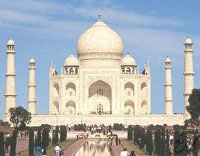Taj Mahal, India's national symbol, lost many of its priceless treasures through centuries
Taj Mahal (otherwise known as “the Taj”) is the most popular (though unofficial) symbol of India. The monument was constructed in Agra, India, between 1631 and 1654. The Mughal Emperor Shan Jahan commissioned the construction as a mausoleum to his favorite wife, Arjumand Banu Begum, who is also known as Mumtaz Mahal.

According to one of the most romantic legends, the future Shah Jahan met a beautiful girl while having a stroll along the bazaar on a lazy afternoon. The girl was wearing bracelets made of tiny wooden beads around her wrists. She gave him just one look. The prince Jahan was apparently spellbound. He decided to marry the beautiful girl and stay inseparable till death do them part. The meeting reportedly took place in 1612. The girl was 19 years old - way beyond her prime - even by the standards of a present-day India.
The Shah Jahan ascended the throne in 1628. Not unlike any other dignitary at the time, he had a big harem. But he seemed to have ignored his other women because he was totally devoted to his favorite wife, Mumtaz Mahal. Visiting Agra in 1663, the French traveller François Bernier gave the following description of the Taj Mahal and Shah Jahan's reasons for building it:
“I shall finish this letter with a description of the two wonderful mausoleums which constitute the chief superiority of Agra over Delhi . One was erected by Jehan-guyre [sic] in honour of his father Ekbar; and Chah-Jehan raised the other to the memory of his wife Tage Mehale, that extraordinary and celebrated beauty, of whom her husband was so enamored it is said that he was constant to her during life, and at her death was so affected as nearly to follow her to the grave.”
Shan Jahan was reportedly inconsolable following the death of his beloved wife in childbirth in 1629. Mumtaz Mahal had already borne him thirteen children during 17 years of conjugal bliss. Having been informed of his wife’s demise, the shah was on the verge of taking his own life. His hair turned gray overnight. Six months later, he brought the body of his wife to Agra, where he decided to erect a mausoleum that would do proper homage to his late wife in terms of excellence.
The Taj Mahal was not designed by a single person. The project demanded talent from many quarters.The names of many of the builders who participated in the construction of the Taj Mahal in different capacities have come down to us through various sources.Ustad Isa and Isa Muhammad Effendi trained by the great Ottoman architect Koca Mimar Sinan Agha had a key role in the architectural design of the complex.
'Puru' from Benarus, Persia, has been mentioned as the supervising architect in Persian language texts.The main dome was designed by Ismail Khan from the Ottoman Empire, thought to be the head designer of hemispheres and builder of domes of that age. Qazim Khan cast the solid gold finial that crowned the Turkish master's dome. Chiranjilal, a lapidary from, was chosen as the chief sculptor and mosaicist. Amanat Khan from Persian Shiraz, Persia, was the chief calligrapher (this factis attestedon the Taj Mahal gateway itself, where his name has been inscribed at the end of the inscription). Legend has it that two Western architects that came from Venice and France were employed for the constriuction of the Taj. However, their names vanished in the ozone.
Perhaps the Westerners contributed to the constuction of the marvelous park leading to the mausoleum. The complex is set in and around a large charbagh (a formal Mughal garden divided into four parts). Measuring 320 m × 300 m, the garden has sunken parterres or flowerbeds, raised pathways, avenues of trees, fountains, water courses, and pools that reflect the Taj Mahal.
Each of the four quarters of the garden is divided into 16 flowerbeds by raised pathways. A raised marble water tank at the centre of the garden, halfway between the tomb and the gateway, reflects the Taj Mahal.
The charbagh garden was introduced to India by the first Mughal emperor Babur, a design inspired by Persian gardens. The charbagh is meant to reflect the gardens of Paradise (from the Persian paridaeza -- a walled garden). In mystic Islamic texts of the Mughal period, paradise is described as ideal garden, filled with abundance. Water plays a key role in these descriptions: In Paradise, these text say, four rivers source at a central spring or mountain, and separate the garden into north, west, south and east.
Soon after its completion, Shah Jahan was deposed and put under house arrest at nearby Agra Fort by his son Aurangzeb. Legend has it that he spent the remainder of his days staring through the window at the Taj Mahal. Upon Shah Jahan's death, Aurangzeb buried him in the Taj Mahal next to his wife, the only disruption of the otherwise perfect symmetry in the architecture. By the late 19th century parts of the Taj Mahal had fallen badly into disrepair. During the time of the First war of Indian Independence the Taj Mahal faced defacement by British soldiers, sepoys, and government officials who chiseled out precious stones and lapis lazuli from its walls.
In the laste 19th century the British viceroy Lord Curzon ordered a massive restoration project, completed in 1908. He also commissioned the large lamp in the interior chamber. It was during this time the garden was remodeled with the more English looking lawns visible today. In 1942 the government erected a behemoth scaffolding over it in anticipation of an air attack by the German Luftwaffe and later by the Japanese Air Force. During the India-Pakistan wars of 1965 and 1971 scaffoldings were erected by the government to mislead would-be bomber pilots.
As of 1983 the Taj Mahal was designated a UNESCO World Heritage Site. Today it is a major tourist destination.
The Taj Mahal is often described as one of the seven wonders of the modern world. Millions of tourists have visited the site - more than three million in 2004, according to the BBC - making it one of the most popular international attractions in India.
Translated by Guerman Grachev
Pravda.Ru
Subscribe to Pravda.Ru Telegram channel, Facebook, RSS!





